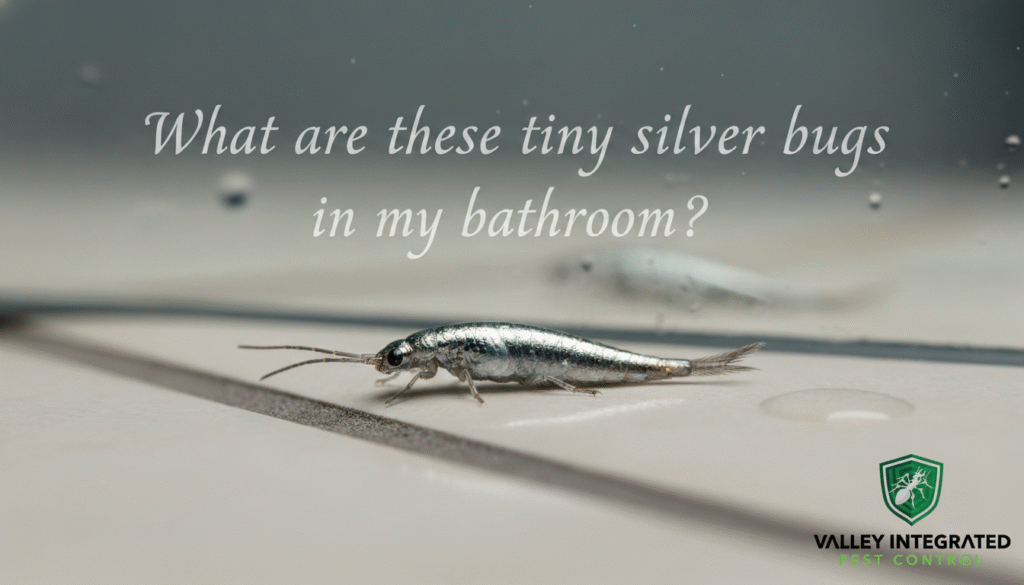If you’ve spotted a fast moving silver bug on floor of your bathroom late at night, you’ve likely encountered a silverfish. These small, wingless insects are not just a random nuisance; they are a clear indicator of a deeper issue. The presence of these pests is a living alarm system signaling that your bathroom has excess moisture, an environment that can lead to far more serious problems like mold and structural decay if left unaddressed.
Your bathroom’s unwanted guest: Identifying the silver bug with long antennae

So, what are the little silver bugs in my bathroom? And what about the little grey bugs in my bathroom? In most cases, they are one and the same: Lepisma saccharinum, commonly known as the silverfish. This teardrop shaped silver insect gets its name from its silvery, metallic sheen and the fish-like, wiggling way it moves. You might also notice two long antennae on its head and three tail-like appendages at its rear.
You’ll typically see them in damp, dark areas. While the bathroom is a prime location, you may also find silverfish in kitchen cabinets, basements, and laundry rooms. They are nocturnal, which is why you often surprise them when you flick on a light in the middle of the night, sending them scurrying for cover under a baseboard or into a drain. Many homeowners wonder, are silverfish harmful? The good news is they do not bite and are not known to carry diseases. However, their diet can be destructive to your property. What do silverfish eat? They feed on starches and sugars, a substance called polysaccharides. This means they are notorious for silverfish eating paper and books, glue in wallpaper, linens, and even some textiles. If you’ve ever wondered, do silverfish eat clothes, the answer is yes, particularly items made of cotton or rayon stored in a humid place.
It’s also important to distinguish them from similar pests. People sometimes confuse them with firebrats, a close relative that prefers much hotter environments, like near furnaces or water heaters. While their control methods are similar, correctly identifying the bug helps pinpoint the environmental issue in your home.
Why a silverfish is more than just a bug: It’s a living warning sign
Finding a single, lone silverfish might not be cause for panic. It could be an isolated visitor that found its way inside. But this brings up a crucial question: should I be worried if I see a silverfish? The answer lies in frequency. If you consistently see them, it crosses what we call the ‘Infestation Threshold’. This consistent presence is a definitive red flag that a persistent environmental issue exists in your home.
These insects are classified as “occasional invaders.” This means they typically enter structures when conditions indoors are better for them than outdoor conditions, signaling an environmental imbalance in the home. That imbalance is almost always excess moisture. As pest expert Ed Dolshun notes, “If you spot [silverfish] often, there may be a moisture or shelter problem somewhere in your home.”
Ignoring this signal is a mistake. The silverfish bug itself is the symptom, not the disease. Focusing only on killing the visible insects with the best spray to kill silverfish is like turning off a smoke alarm while the fire continues to burn. You might get temporary relief, but you haven’t addressed the root cause of what causes silverfish in the bathroom: the water source they need to survive.
The hidden danger: The silverfish and mold connection
The single most important reason to take a silverfish sighting seriously is the silverfish and mold connection. The exact conditions that silverfish find attractive—high humidity (75-95%), darkness, and a food source—are the very same conditions required for mold to grow and thrive. When you see silverfish, you should immediately consider the possibility of hidden mold.
This moisture could be from obvious sources, like condensation from long, hot showers, or from something more sinister. A slow, hidden micro-leak from a pipe behind a wall, a faulty wax ring at the base of your toilet, or improperly sealed tile grout can create a perpetually damp environment. These are common hiding spots for silverfish in bathroom walls and under flooring. Are silverfish a sign of water damage? Yes, they absolutely can be. They are drawn to the damp, decaying organic material that results from prolonged water exposure, making them one of the earliest visible signs of a potentially expensive problem.
From symptom to solution: A deeper look at the problem
To effectively get rid of silverfish, you must shift your focus from the pest to the environment. Understanding the difference between the symptom, the cause, and the consequence is key to protecting your home.
The Symptom: The Visible Pest
This is the fast-moving, teardrop shaped silver insect you see in the bathtub or scurrying from under the sink. It’s easy to focus on this immediate problem with DIY silverfish traps or sprays. While these can offer temporary satisfaction, they do nothing to alter the welcoming environment that drew the pests in, ensuring others will soon take their place.
The Root Cause: The Hidden Moisture Issue
This is the core of the problem. As experts at Good Housekeeping point out, silverfish thrive in moist, humid environments, and fixing the problem may require repairing leaking pipes or ensuring gutters channel water away from the foundation. In the bathroom, this means investigating faulty plumbing, improving ventilation, or sealing gaps that let in damp air. Addressing the moisture is the only way to make your home unattractive to pests for the long term.
The Consequence: Potential Long-Term Property Damage
This is what happens when the root cause is ignored. An unchecked moisture problem can lead to wood rot, peeling paint, warped floorboards, and hazardous mold growth. Furthermore, a full-blown silverfish infestation itself can be destructive. An infestation of silverfish can damage property, including clothing, rugs, upholstery, paper, books, and soft building materials. The cost of repairing this damage far exceeds the cost of early intervention.
How to treat a silverfish problem for good: Your action plan
If you’re committed to a lasting solution, you need a multi-pronged approach that tackles their environment. Here are actionable steps for effective bathroom pest management.
Step 1: Reduce bathroom humidity to stop pests
Your primary goal is to lower the humidity level below 50%. Always use your bathroom’s exhaust fan during and for at least 30 minutes after a shower. If your fan is old or ineffective, consider an upgrade. Clean the vent cover regularly to ensure maximum airflow. On dry days, open a window. In persistently damp climates, a small dehumidifier can make a world of difference.
Step 2: Eliminate their food and water sources
Start by checking for leaks. Look for condensation or discoloration on pipes under the sink and behind the toilet. Inspect the caulk around your bathtub and the grout between your tiles. Cracks and gaps allow water to seep behind walls and under floors. Repairing these seals is one of the most effective ways to control moisture and get rid of silverfish. Regularly cleaning the silverfish in sink drain areas also removes a common water source.
Step 3: Block entry points and hiding spots
Learning how to seal my home from silverfish is a crucial preventative step. Use caulk to fill cracks in baseboards, around window frames, and where pipes enter the walls. This not only blocks silverfish but other pests as well. Furthermore, proactive pest management includes eliminating clutter where pests can shelter and repairing window and door screens. In the bathroom, this means not leaving wet towels or bathmats on the floor.
A note on DIY silverfish traps and treatments
Many homeowners looking for how to get rid of silverfish naturally turn to methods like diatomaceous earth for silverfish or boric acid for silverfish control. These desiccants can be effective at killing the insects they come into contact with. Likewise, natural silverfish repellent options like cedar oil to repel silverfish can help. However, these home remedies for silverfish typically only address the symptom. They kill the bugs that are already there but do little to prevent a new generation from moving in if the underlying moisture problem isn’t solved.
Key factors in choosing your silverfish control strategy
When deciding between a DIY approach and calling a professional silverfish exterminator, consider what matters most for a complete and lasting solution. Effectiveness of Immediate Pest Removal DIY methods can be hit-or-miss and may take time. A professional service can often provide more immediate and comprehensive reduction of the existing pest population using targeted, low-impact products. Identification and Resolution of the Root Cause This is the most significant difference. While you can check for obvious leaks, a professional has the experience and tools (like moisture meters) to find hidden water sources that are often the true cause of the infestation. Prevention of Future Infestations A lasting solution involves treating the current pests and implementing a strategy to prevent their return. This includes identifying and recommending fixes for structural and environmental issues, something a can of bug spray can’t do. Safety of Treatment Methods Professional pest control technicians are trained in the precise and safe application of control products, ensuring the safety of your family and pets while maximizing effectiveness.
Making the right choice for your needs
There is no single “best” answer for how to get rid of silverfish; the right path depends on your situation and goals.
For the Alarmed Homeowner
Your main concern is seeing that “tiny silver insect in house” and wanting it gone now. You need reassurance. The fastest way to get rid of silverfish and gain peace of mind is to call a professional. They can provide immediate relief by treating the active pests while simultaneously beginning the crucial investigation into the underlying moisture issue, ensuring the problem is truly solved.
For the DIY Researcher
You’ve likely already tried getting rid of silverfish without chemicals or have used boric acid. If you’re still seeing them, it’s a strong sign that the moisture source is not obvious. Your research has correctly identified the cause, but finding and fixing it may require specialized knowledge. A professional can be your partner, using their expertise to find the hidden leak or ventilation flaw your diligent efforts couldn’t uncover.
For the Proactive Property Manager
You see these pests not as a nuisance, but as a threat to your investment. For you, a silverfish is a data point indicating a potential maintenance liability. You need a comprehensive assessment. A professional integrated pest management approach is ideal, as it focuses on the long-term health of the property. This means identifying and providing a clear report on the leaks, grout failure, or poor ventilation that needs to be addressed to protect the building’s structural integrity and value.
Ultimately, understanding that the silverfish in your bathroom are messengers is the first step toward a healthier home. By addressing the root cause of moisture, you not only solve your pest problem but also protect your property from the more significant threats of mold and water damage. For a comprehensive inspection and a tailored solution that addresses both the pests and the conditions that attract them, the team at Valley Integrated Pest Control is here to help residents in and around Fresno, CA. Contact us today for a consultation and a clear path to a pest-free, healthy home.






